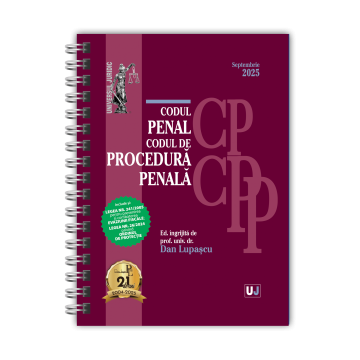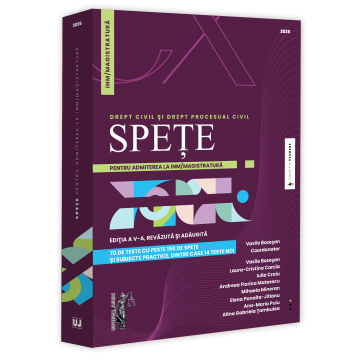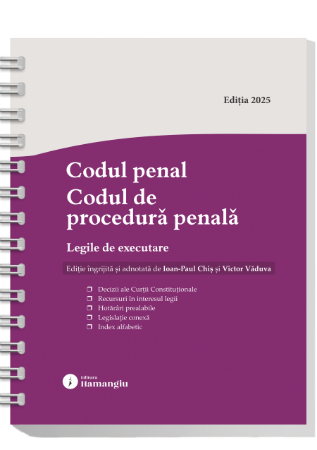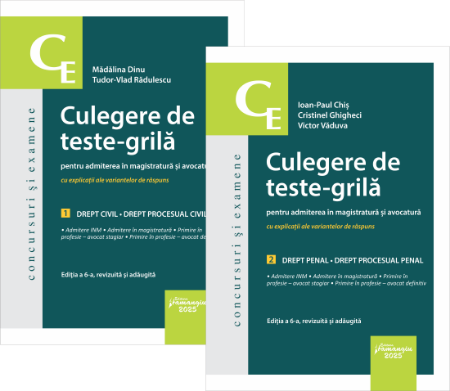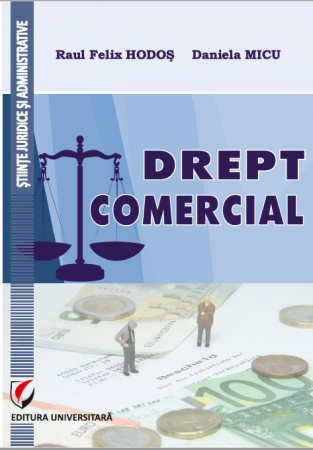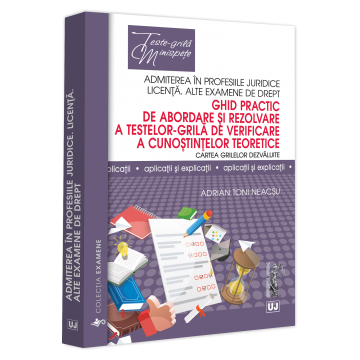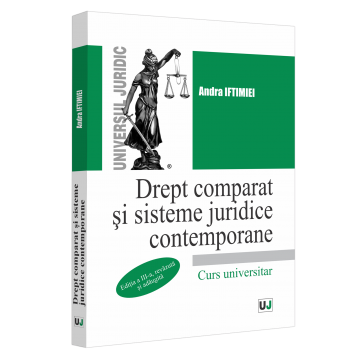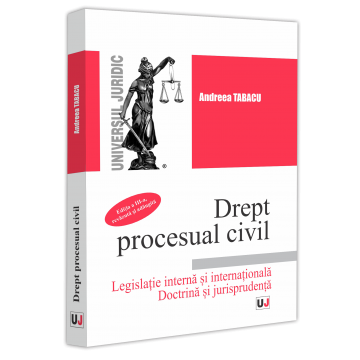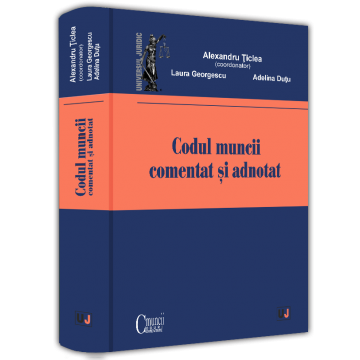Manuscript proposals: [email protected] / 0745 204 115 //// Tracking orders Individuals / Sales: 0745 200 357 / Orders Legal entities: 0721 722 783
6359.png) Cyber security and human rights. The limits of the restriction of human rights for the protection of cyberspace
Cyber security and human rights. The limits of the restriction of human rights for the protection of cyberspace
6359.png)
ISBN: 978-606-28-1360-4
DOI: https://doi.org/10.5682/9786062813604
Publisher year: 2021
Edition: I
Pages: 424
Publisher: Editura Universitară
Author: Alexandra Cerasela Pană
Product Code:
9786062813604
Do you need help?
0745 200 357
- Description
- Download (1)
- Authors
- Content
- More details
- Reviews (0)
This monograph is the doctoral thesis defended in 2021 at the Carlos III University of Madrid, Spain, with as coordinating director the university professor Dr. Jose Manuel Rodriguez Uribes, recognized philosopher of law and politician.
During her doctoral studies, the author also carried out a research internship at the Center for European Law Studies within the "Acad. Andrei Radulescu" Institute of Legal Research of the Romanian Academy, under the careful guidance of Professor Dr. Mihai Daniel Sandru.
The doctoral thesis is written in Spanish and contains a summary and conclusions in English and Romanian.
In the context in which the citizen's life migrates more and more to the virtual space - virtual communities, internet banking, telemedicine, information and research from digital sources, electronic commerce, virtual dating, virtual reality, etc. - the measures to protect the individual in space cybernetics must be thought of in direct correlation with security measures specific to the offline environment. If the off-line environment is well determined and has actors with clear roles (states, administrative territories, institutions with responsibilities in the field of citizen security and safety, etc.), the virtual space is still a jungle, without defined limits and without supervisory bodies that could protect vulnerable users if they become victims of digital criminals (fake-news authors, pedophiles, digital spies, bullies, thieves of identity or personal data, etc.).
The research aimed at analyzing the legal framework applicable to the restriction of the exercise of fundamental rights as well as the legal norms that protect the right to privacy, the right to information and free expression. Cyber security and the normative framework applicable both at European and international level, represent two other topics of interest of the thesis.
During her doctoral studies, the author also carried out a research internship at the Center for European Law Studies within the "Acad. Andrei Radulescu" Institute of Legal Research of the Romanian Academy, under the careful guidance of Professor Dr. Mihai Daniel Sandru.
The doctoral thesis is written in Spanish and contains a summary and conclusions in English and Romanian.
In the context in which the citizen's life migrates more and more to the virtual space - virtual communities, internet banking, telemedicine, information and research from digital sources, electronic commerce, virtual dating, virtual reality, etc. - the measures to protect the individual in space cybernetics must be thought of in direct correlation with security measures specific to the offline environment. If the off-line environment is well determined and has actors with clear roles (states, administrative territories, institutions with responsibilities in the field of citizen security and safety, etc.), the virtual space is still a jungle, without defined limits and without supervisory bodies that could protect vulnerable users if they become victims of digital criminals (fake-news authors, pedophiles, digital spies, bullies, thieves of identity or personal data, etc.).
The research aimed at analyzing the legal framework applicable to the restriction of the exercise of fundamental rights as well as the legal norms that protect the right to privacy, the right to information and free expression. Cyber security and the normative framework applicable both at European and international level, represent two other topics of interest of the thesis.
-
Cyber security and human rights. The limits of the restriction of human rights for the protection of cyberspace
Download
ALEXANDRA CERASELA PANA
ACKNOWLEDGMENTS / 5
CONTENT PUBLISHED AND PRESENTED / 6
INTRODUCTION / 11
CHAPTER I. The concept of Cyber Security / 26
1.1. Cyber Security and International Law / 28
1.2. The international regulatory framework related to cyberattacks / 37
1.2.a. Possible Reactions in the Absence of a Demonstrated Violation of International Law / 42
1.2.b. Possible reactions in the event of a proven violation of international law by another State / 54
CHAPTER II. Active Cyber Security and Defensive Cyber Security / 73
2.1. The Active (Offensive) Cybersecurity Policy / 75
2.1.a. The advantages of the practice of hack back / 77
2.1.b. The downsides and risks associated with hack back / 82
2.2. Defensive Cybersecurity Policy / 91
CHAPTER III. European cybersecurity policy / 108
3.1. Previous considerations / 108
3.2. The Sources of European Law / 112
3.3. Cybersecurity Policy in the European Union / 116
3.4. The evolution of the legal framework in the field of cybersecurity. The role of the European Union Cyber Security Agency (ENISA) / 118
3.4.1. The regulatory framework / 118
3.4.2. The Functions of the Agency / 123
3.5. The European Regulatory Framework on Cyber Security Certification / 128
CHAPTER IV. Fundamental rights in the era of new technologies / 134
4.1. General considerations on fundamental rights / 134
4.2. The Importance of Fundamental Rights in Contemporary Society / 135
4.3. The concept of fundamental rights. Concept and classification / 138
4.3.1. Concept / 138
4.3.2. Classification of Fundamental Rights / 146
4.4. The legal framework on fundamental rights / 153
4.4.1. The recognition of fundamental rights at the state level / 153
4.4.2. European regulatory framework on fundamental rights / 161
4.4.3. The recognition of fundamental rights at the international level / 170
4.5. The relationship between the rights of the fourth generation and other fundamental rights / 175
4.6. Personality rights: a new category of fundamental rights? / 177
4.7. Theoretical opinions on the fundamental nature of some rights / 182
CHAPTER V. The new fundamental “digital rights” / 190
5.1. The right to digital life or the right to exist digitally / 190
5.2. The right to digital identity / 192
5.3. The Right to Digital Reputation / 195
5.4. The right to freedom of expression and digital responsibility / 197
5.5. Virtual privacy and the right to be forgotten / 200
5.6. The right to digital domicile / 203
5.7. The right to big reply / 205
5.8. The right to the technique, to update, to patch / 207
5.9. The right to computer security and cyber peace / 209
5.10. The right to a digital will / 210
CHAPTER VI. Mechanisms to guarantee fundamental rights / 213
6.1. Universal Supranational Mechanisms / 215
6.1.a. Guarantees of institutional control implemented by United Nations agencies / 217
6.1.b. Mechanisms of legal control by the system of pacts and agreements / 223
6.1.c. The effects determined by the activation of the monitoring mechanisms of human rights by the UN / 227
6. 2. Institutional and legal mechanisms implemented at the regional level to guarantee and protect human rights / 233
6.2.a. Protection mechanisms in the European system / 233
6.2.b. Protection Mechanisms in the African System / 237
6.2.c. Protection Mechanisms in the Inter-American System / 240
6.3. Mechanisms implemented at the state level / 243
6.3.1. Institutional State Mechanisms / 243
6.3.2. Jurisdictional mechanisms / 246
6.3.3. Types of legal responsibility in case of violation of fundamental rights / 248
6.3.3.1. Criminal civil liability / 249
6.3.3.2. Criminal responsibility / 250
6.3.3.3. Administrative and misconduct liability / 254
CHAPTER VII. The right to privacy / 258
7.1. The legal nature of the right to privacy / 268
7.2. The character of the fundamental right to privacy in national systems of law / 270
7.2.1. The Anglo-Saxon Law System / 270
7.2.2. The Continental Law System / 272
7.3. The character of the fundamental right to privacy at the level of international organizations / 277
7.4. Elements of the right to privacy / 282
7.4.1. The Right to a Name / 288
7.4.2. The right to identity / 290
7.4.3. The right to one's own image / 294
7.4.4. The right to dispose of one's own person / 299
7.4.5. The right to physical and moral integrity / 302
7.4.6. The Right to Honor / 304
7.4.7. The right to be forgotten / 308
7.5. Active and passive subjects of the right to privacy / 312
7.6. The right to privacy and other fundamental rights / 319
7.6.1. Complementary rights to the right to privacy / 320
7.6.2. Rights opposed to the right to privacy / 332
Chapter VIII. Limitations of Fundamental Rights / 343
8.1. The right to security and surveillance / 347
8.2. Digital surveillance and legal guarantees of the right to privacy / 355
8.3. Standards for the protection of the right to privacy against digital surveillance / 359
8.4. Retention and use of personal data in intelligence activities / 368
CONCLUSIONES / 378
CONCLUSIONS / 400
BIBLIOGRAPHY / 405
CONTENT PUBLISHED AND PRESENTED / 6
INTRODUCTION / 11
CHAPTER I. The concept of Cyber Security / 26
1.1. Cyber Security and International Law / 28
1.2. The international regulatory framework related to cyberattacks / 37
1.2.a. Possible Reactions in the Absence of a Demonstrated Violation of International Law / 42
1.2.b. Possible reactions in the event of a proven violation of international law by another State / 54
CHAPTER II. Active Cyber Security and Defensive Cyber Security / 73
2.1. The Active (Offensive) Cybersecurity Policy / 75
2.1.a. The advantages of the practice of hack back / 77
2.1.b. The downsides and risks associated with hack back / 82
2.2. Defensive Cybersecurity Policy / 91
CHAPTER III. European cybersecurity policy / 108
3.1. Previous considerations / 108
3.2. The Sources of European Law / 112
3.3. Cybersecurity Policy in the European Union / 116
3.4. The evolution of the legal framework in the field of cybersecurity. The role of the European Union Cyber Security Agency (ENISA) / 118
3.4.1. The regulatory framework / 118
3.4.2. The Functions of the Agency / 123
3.5. The European Regulatory Framework on Cyber Security Certification / 128
CHAPTER IV. Fundamental rights in the era of new technologies / 134
4.1. General considerations on fundamental rights / 134
4.2. The Importance of Fundamental Rights in Contemporary Society / 135
4.3. The concept of fundamental rights. Concept and classification / 138
4.3.1. Concept / 138
4.3.2. Classification of Fundamental Rights / 146
4.4. The legal framework on fundamental rights / 153
4.4.1. The recognition of fundamental rights at the state level / 153
4.4.2. European regulatory framework on fundamental rights / 161
4.4.3. The recognition of fundamental rights at the international level / 170
4.5. The relationship between the rights of the fourth generation and other fundamental rights / 175
4.6. Personality rights: a new category of fundamental rights? / 177
4.7. Theoretical opinions on the fundamental nature of some rights / 182
CHAPTER V. The new fundamental “digital rights” / 190
5.1. The right to digital life or the right to exist digitally / 190
5.2. The right to digital identity / 192
5.3. The Right to Digital Reputation / 195
5.4. The right to freedom of expression and digital responsibility / 197
5.5. Virtual privacy and the right to be forgotten / 200
5.6. The right to digital domicile / 203
5.7. The right to big reply / 205
5.8. The right to the technique, to update, to patch / 207
5.9. The right to computer security and cyber peace / 209
5.10. The right to a digital will / 210
CHAPTER VI. Mechanisms to guarantee fundamental rights / 213
6.1. Universal Supranational Mechanisms / 215
6.1.a. Guarantees of institutional control implemented by United Nations agencies / 217
6.1.b. Mechanisms of legal control by the system of pacts and agreements / 223
6.1.c. The effects determined by the activation of the monitoring mechanisms of human rights by the UN / 227
6. 2. Institutional and legal mechanisms implemented at the regional level to guarantee and protect human rights / 233
6.2.a. Protection mechanisms in the European system / 233
6.2.b. Protection Mechanisms in the African System / 237
6.2.c. Protection Mechanisms in the Inter-American System / 240
6.3. Mechanisms implemented at the state level / 243
6.3.1. Institutional State Mechanisms / 243
6.3.2. Jurisdictional mechanisms / 246
6.3.3. Types of legal responsibility in case of violation of fundamental rights / 248
6.3.3.1. Criminal civil liability / 249
6.3.3.2. Criminal responsibility / 250
6.3.3.3. Administrative and misconduct liability / 254
CHAPTER VII. The right to privacy / 258
7.1. The legal nature of the right to privacy / 268
7.2. The character of the fundamental right to privacy in national systems of law / 270
7.2.1. The Anglo-Saxon Law System / 270
7.2.2. The Continental Law System / 272
7.3. The character of the fundamental right to privacy at the level of international organizations / 277
7.4. Elements of the right to privacy / 282
7.4.1. The Right to a Name / 288
7.4.2. The right to identity / 290
7.4.3. The right to one's own image / 294
7.4.4. The right to dispose of one's own person / 299
7.4.5. The right to physical and moral integrity / 302
7.4.6. The Right to Honor / 304
7.4.7. The right to be forgotten / 308
7.5. Active and passive subjects of the right to privacy / 312
7.6. The right to privacy and other fundamental rights / 319
7.6.1. Complementary rights to the right to privacy / 320
7.6.2. Rights opposed to the right to privacy / 332
Chapter VIII. Limitations of Fundamental Rights / 343
8.1. The right to security and surveillance / 347
8.2. Digital surveillance and legal guarantees of the right to privacy / 355
8.3. Standards for the protection of the right to privacy against digital surveillance / 359
8.4. Retention and use of personal data in intelligence activities / 368
CONCLUSIONES / 378
CONCLUSIONS / 400
BIBLIOGRAPHY / 405
Currently, society changes and moves from the street to social networks and platforms. The world changes and the material world becomes more and more a virtual world. Modern society evolves, changes, and moves to social networks and virtual platforms, leading to our feelings manifesting in short phrases and emoticons. Communication is compressed into short or cut words, letters are transformed into emails with a maximum of two sentences, and time is no longer enough for any of our plans.
In all this storm of transformations, what are we going to do with our rules of coexistence and with our legal system? All the principles and rules of our society have to be transferred to the new cybernetic society. It is the moment when Law, as a social science, is facing a great challenge: that of adapting to the open space created on the Internet or falling into disuse.
The www (World Wide Web) is being organized and passes from the simple user to virtual communities, which implies the importation of social rules in the virtual world. It is also the ideal time to reform and improve social and legal systems.
In classical society we are used to being protected by various authorities that ensure that our fundamental rights are guaranteed: freedom, physical integrity, property, security, etc. But in virtual society, who watches over our rights and guarantees their respect in the event of any violation?
At the same time, it is important to know the cost of protecting human beings in cyberspace. This thesis tries to identify the most vulnerable fundamental rights in the new online environment and the responsible authorities to protect them.
At the same time, the fair price of cyber security will be analyzed, in an analog way with the individual security that we enjoy every day in our classic societies. As we already know, sometimes the price of security is the limitation of other fundamental human rights, such as the right to private life (surveillance, intervention in private conversations, etc.), the right to freedom (detention of possible violators), the right to free expression (censorship of materials or media with illegal or immoral content), the right to freedom of movement or to move freely (prohibition of illegal immigration) and other rights of the person that interfere with the social rules when exercised beyond established limits.
At first, Internet networks were born free, as a space where the Internet user can express himself in any way according to his own limits. A situation similar to the garden of Eden. But, over time, the number of virtual users has increased and the digital environment has become a labyrinth and a true Babel Tower, where each user speaks their language and expresses a variety of thoughts, according to their interests. It is the growth of the internet, its massive use and the appearance of more and more conflicts when it made us think that it was necessary to regulate it. It was thought about the need to create regulations and control bodies for its correct use.
After the appearance of regulatory and surveillance bodies on the Internet, all the problems related to the intervention of such bodies in the private life of citizens appeared. A clear legal framework had to be established that would establish the clear border between the need to control the virtual spacer of the Internet and the protection of the rights and freedoms of Internet users. For Human Rights organizations there is a danger of restriction of human rights in digital networks. Human rights activists have transferred their struggle to the digital environment: "keeping the Internet free and open" is the slogan of all their virtual demonstrations. But none of these activists propose solutions for the cyber security of the human being (the virtual user), which is also one of our fundamental rights closely related to the right to life. The right to security guarantees full compliance with the other fundamental rights of the human being and the free exercise of these rights within the limits established by the rights of others.
Well, the right to cyber security of the user allows this individual to manifest freely and protected in the online environment, without being afraid that their personal data may be stolen, that their intellectual property rights will not be violated, that their privacy will not be violated by other users, that your conversations will not be published without your consent. To guarantee your right to cybersecurity, some organizations have to "watch over" the virtual environment.
As in classical society, sometimes, states and authorities responsible for "monitoring" respect for social norms and the safety of the individual go a little more than the limits and intervene in the private life of people "a little more than is owed ”. For these reasons, international society established rules and limits for the intervention of the authorities in the lives of the protected. At the same time, international and state organizations and bodies are analyzing and exposing cases of abuse by states or authorities.
The virtual world opened opportunities both for individuals and for private states and organizations. International, state-sponsored cyber espionage has given birth to new notions such as “cyber warfare” and a new cyber weapons industry. The new stories are being used in some parts of the world to encourage citizens to give up civil liberties for a greater sense of security. In the US, for example, cyber espionage practiced by Chinese hackers is a key argument used to support the controversial "Cyber Intelligence Sharing and Protection Act" (CISPA) that would allow authorities to access large quantities of user data without a court order.
Elsewhere, internal threats to national security posed by the use of new technologies have been used to justify extensive surveillance measures. For example, in India, it is not possible to access mobile phones or Internet connections, even in Internet cafes, without official identification, and Internet providers and Internet cafes are required to keep detailed records of the browsing history of the Internet. the users.
The narratives of doom that invariably accompany such measures are further based on the force of the actual growth of cybercrime that there are now said to be more than 150,000 viruses and other types of malicious code in circulation, with one million people they become victims of cyber crime every day.
In this way, the issue of cybersecurity and the protection of citizens' rights in the networks worries every time and is a controversial issue. States and political and social agents are increasingly speaking out on this problem, also in the international arena.
In reality, there are real threats and they are growing. Illegal access to data and computers, as well as data interference, have become more common and complex problems affecting large numbers of people. Topics such as: fraud is taking new forms on the Internet, and as more of our critical infrastructure becomes dependent on the Internet, security breaches can have significant repercussions, including human rights impacts when, for example, an attack prevents people have access to public services or the exercise of their right to expression.
The obligation of the States is to guarantee the rights and freedoms within their territory and change on this issue, not so new anymore, of the massive use of the networks and the criminality that accompanies it.
However, cybersecurity strategies must be designed and implemented in a way that is convergent with international human rights law. Too often this is not the case, as seen in the surveillance regimes described above. The application of human rights protection standards to Cyber Security policies will be based, first of all, on familiarizing all the actors involved with human rights standards and promoting them consistently.
In other cases, states were even behind threats such as cyber attacks directed at human rights defenders or political opposition. Therefore, it is important that the human rights community begins to engage with these discourses more closely, to nullify the threats against them. In addition, they must offer solution proposals so that human rights rules and norms are not repeated and guaranteed also in digital networks, guaranteeing cybersecurity at the same time.
The research carried out in this thesis seeks to identify and analyze the neuralgic points in the set of fundamental rights that are activated with the interaction of the human being and the virtual world. The main objective of this thesis is to establish the limits of legal intrusions on individual rights by the authorities, using new technologies and the Internet. To find answers to the questions that will be formulated later, various sources of information were used, such as: the texts of international treaties and regional conventions on human rights, the constitutional texts of different countries, but with a special emphasis on the legal framework of Spain and Romania, the constitutional doctrine emanating from the jurisdictional bodies, and the doctrinal pronouncements.
Among the research methods used to reach the desired conclusions, we mention the comparative method (the norms that regulate fundamental rights in different systems of law have been compared), the historical method (presenting the evolution of rights in recent years), the correlational method and the deductive method to propose solutions adapted to new challenges.
The thesis will be developed in eight chapters that deal with the legal problems and challenges mentioned in the previous paragraphs. In general terms, the research focuses on finding answers to three major questions about the content of the notion of cybersecurity, the existence of a rule of law in the digital environment and the possibility of regulating user behavior in the virtual space in harmony with the interests of collective security and respect for human rights.
In all this storm of transformations, what are we going to do with our rules of coexistence and with our legal system? All the principles and rules of our society have to be transferred to the new cybernetic society. It is the moment when Law, as a social science, is facing a great challenge: that of adapting to the open space created on the Internet or falling into disuse.
The www (World Wide Web) is being organized and passes from the simple user to virtual communities, which implies the importation of social rules in the virtual world. It is also the ideal time to reform and improve social and legal systems.
In classical society we are used to being protected by various authorities that ensure that our fundamental rights are guaranteed: freedom, physical integrity, property, security, etc. But in virtual society, who watches over our rights and guarantees their respect in the event of any violation?
At the same time, it is important to know the cost of protecting human beings in cyberspace. This thesis tries to identify the most vulnerable fundamental rights in the new online environment and the responsible authorities to protect them.
At the same time, the fair price of cyber security will be analyzed, in an analog way with the individual security that we enjoy every day in our classic societies. As we already know, sometimes the price of security is the limitation of other fundamental human rights, such as the right to private life (surveillance, intervention in private conversations, etc.), the right to freedom (detention of possible violators), the right to free expression (censorship of materials or media with illegal or immoral content), the right to freedom of movement or to move freely (prohibition of illegal immigration) and other rights of the person that interfere with the social rules when exercised beyond established limits.
At first, Internet networks were born free, as a space where the Internet user can express himself in any way according to his own limits. A situation similar to the garden of Eden. But, over time, the number of virtual users has increased and the digital environment has become a labyrinth and a true Babel Tower, where each user speaks their language and expresses a variety of thoughts, according to their interests. It is the growth of the internet, its massive use and the appearance of more and more conflicts when it made us think that it was necessary to regulate it. It was thought about the need to create regulations and control bodies for its correct use.
After the appearance of regulatory and surveillance bodies on the Internet, all the problems related to the intervention of such bodies in the private life of citizens appeared. A clear legal framework had to be established that would establish the clear border between the need to control the virtual spacer of the Internet and the protection of the rights and freedoms of Internet users. For Human Rights organizations there is a danger of restriction of human rights in digital networks. Human rights activists have transferred their struggle to the digital environment: "keeping the Internet free and open" is the slogan of all their virtual demonstrations. But none of these activists propose solutions for the cyber security of the human being (the virtual user), which is also one of our fundamental rights closely related to the right to life. The right to security guarantees full compliance with the other fundamental rights of the human being and the free exercise of these rights within the limits established by the rights of others.
Well, the right to cyber security of the user allows this individual to manifest freely and protected in the online environment, without being afraid that their personal data may be stolen, that their intellectual property rights will not be violated, that their privacy will not be violated by other users, that your conversations will not be published without your consent. To guarantee your right to cybersecurity, some organizations have to "watch over" the virtual environment.
As in classical society, sometimes, states and authorities responsible for "monitoring" respect for social norms and the safety of the individual go a little more than the limits and intervene in the private life of people "a little more than is owed ”. For these reasons, international society established rules and limits for the intervention of the authorities in the lives of the protected. At the same time, international and state organizations and bodies are analyzing and exposing cases of abuse by states or authorities.
The virtual world opened opportunities both for individuals and for private states and organizations. International, state-sponsored cyber espionage has given birth to new notions such as “cyber warfare” and a new cyber weapons industry. The new stories are being used in some parts of the world to encourage citizens to give up civil liberties for a greater sense of security. In the US, for example, cyber espionage practiced by Chinese hackers is a key argument used to support the controversial "Cyber Intelligence Sharing and Protection Act" (CISPA) that would allow authorities to access large quantities of user data without a court order.
Elsewhere, internal threats to national security posed by the use of new technologies have been used to justify extensive surveillance measures. For example, in India, it is not possible to access mobile phones or Internet connections, even in Internet cafes, without official identification, and Internet providers and Internet cafes are required to keep detailed records of the browsing history of the Internet. the users.
The narratives of doom that invariably accompany such measures are further based on the force of the actual growth of cybercrime that there are now said to be more than 150,000 viruses and other types of malicious code in circulation, with one million people they become victims of cyber crime every day.
In this way, the issue of cybersecurity and the protection of citizens' rights in the networks worries every time and is a controversial issue. States and political and social agents are increasingly speaking out on this problem, also in the international arena.
In reality, there are real threats and they are growing. Illegal access to data and computers, as well as data interference, have become more common and complex problems affecting large numbers of people. Topics such as: fraud is taking new forms on the Internet, and as more of our critical infrastructure becomes dependent on the Internet, security breaches can have significant repercussions, including human rights impacts when, for example, an attack prevents people have access to public services or the exercise of their right to expression.
The obligation of the States is to guarantee the rights and freedoms within their territory and change on this issue, not so new anymore, of the massive use of the networks and the criminality that accompanies it.
However, cybersecurity strategies must be designed and implemented in a way that is convergent with international human rights law. Too often this is not the case, as seen in the surveillance regimes described above. The application of human rights protection standards to Cyber Security policies will be based, first of all, on familiarizing all the actors involved with human rights standards and promoting them consistently.
In other cases, states were even behind threats such as cyber attacks directed at human rights defenders or political opposition. Therefore, it is important that the human rights community begins to engage with these discourses more closely, to nullify the threats against them. In addition, they must offer solution proposals so that human rights rules and norms are not repeated and guaranteed also in digital networks, guaranteeing cybersecurity at the same time.
The research carried out in this thesis seeks to identify and analyze the neuralgic points in the set of fundamental rights that are activated with the interaction of the human being and the virtual world. The main objective of this thesis is to establish the limits of legal intrusions on individual rights by the authorities, using new technologies and the Internet. To find answers to the questions that will be formulated later, various sources of information were used, such as: the texts of international treaties and regional conventions on human rights, the constitutional texts of different countries, but with a special emphasis on the legal framework of Spain and Romania, the constitutional doctrine emanating from the jurisdictional bodies, and the doctrinal pronouncements.
Among the research methods used to reach the desired conclusions, we mention the comparative method (the norms that regulate fundamental rights in different systems of law have been compared), the historical method (presenting the evolution of rights in recent years), the correlational method and the deductive method to propose solutions adapted to new challenges.
The thesis will be developed in eight chapters that deal with the legal problems and challenges mentioned in the previous paragraphs. In general terms, the research focuses on finding answers to three major questions about the content of the notion of cybersecurity, the existence of a rule of law in the digital environment and the possibility of regulating user behavior in the virtual space in harmony with the interests of collective security and respect for human rights.
If you want to express your opinion about this product you can add a review.
write a review

![Cyber security and human rights. The limits of the restriction of human rights for the protection of cyberspace [1] Cyber security and human rights. The limits of the restriction of human rights for the protection of cyberspace [1]](https://gomagcdn.ro/domains/editurauniversitara.ro/files/product/large/pana-alexandra_la-seguridad-cibernetica_bt-3431-6287.jpg)


